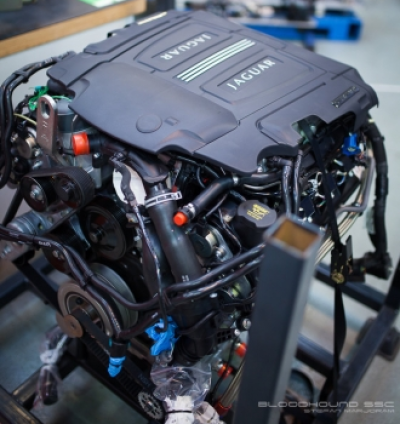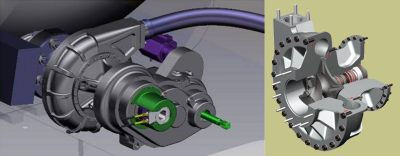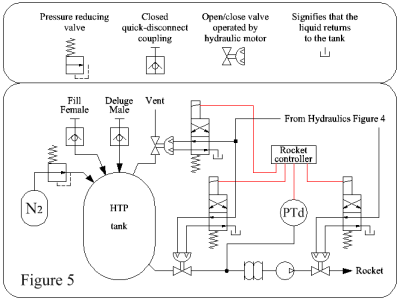The rocket is a hybrid, being specially developed for Bloodhound & the largest ever designed in Europe. Hybrid means that the fuel has a solid & a liquid component.
There are four main elements to Bloodhound's propulsion package: the combustion chamber (containing the solid fuel), the liquid oxidiser, its pumping mechanism, & the associated control kit.
The combustion chamber consists of a composite case containing solid fuel made from synthetic rubber similar to that used in aircraft tyres (HTPB, or Hydroxyl-Terminated Polybutadiene), with metal powders & burning rate modifiers added to the mix.
Digressing, the rocket was originally being developed by Dan Jubb of Falcon rockets. A small version was built & tested, with a successful result. Then Bloodhound & Falcon parted company & Nammo, a Norwegian rocket company, took over.
The liquid oxidiser is 86% hydrogen peroxide in water, known as High Test Peroxide (SG 1.35). In lower strength concentrations it is commonly used to bleach paper & dye hair.
The tank is pressurised by inert nitrogen. The rocket chamber is at a pressure of 53kPa. During a record run, 963kg of HTP has to be delivered against this pressure differential to the rocket in under 20s. This presents a significant technical challenge. Bloodhound's solution starts with a Jaguar engine.
This engine, donated by Jaguar, is a V8 from a road car. It will be subjected to -3G acceleration for 40s - not something it was originally designed to withstand. Digressing once again, the engine was originally intended to be a Cosworth F1, which gave 597kW at 18,000rpm. The Jaguar engine gives 410kW at probably around 6,000rpm.
The engine drives a gearbox which drops the revs to those required by the pump..
Built by Avro, Blue Steel was cruise missile which carried a 1.1 megaton Red Snow air-burst thermonuclear warhead, & was powered by a two-chamber liquid-fuelled (kerosene & hydrogen peroxide) Stentor rocket created by Armstrong Siddeley. John Scott-Scott worked for Armstrong Siddeley on the Stentor oxidant pump. Dan Jubb knew John Scott-Scott, who suggested this pump for the Bloodhound.
When Blue Steel was scrapped in 1970 it was destroyed in toto; the design drawings were burnt. Nine years of research gone (see also TSR2, on the internet).
So John Scott-Scott did not have the design drawings. But what he did have, incredibly, was an actual Stentor pump (now in the Rolls Royce Heritage Trust Collection in Derby). Turns out that when Britain shut down Blue Steel they weren't quite as careful as they imagined: Scott-Scott saw a Stentor pump in a rubbish skip, thought: "Seems a shame to leave that there", and promptly nicked it.
Having a pump is not enough; the design specifications were necessary & would have been preferable. One has no idea whether components are at the high end or low end of the design tolerances; of the hydrostatic loading on the seals; of the material specs. Reverse-engineering, which is a very great deal more difficult than it sounds, is necessary.
Daniel Jubb, John Scott-Scott, Ron Ayers & Richard Noble descended on Dr Michael Fopp, the energetic Director General of the RAF Museums at Hendon & Cosford. This resulted in access to RAF Hendon's quite incredible archives - & lo, there under Blue Steel were the material specs & a little more information. So then the trail led to the Public Records Office, where they found more information.
To cut a long story short, they found enough information to enable Dan Jubb, with the help of John Scott-Scott, to modify the Stentor pump to exactly match the requirements of the Falcon rocket. The new design is 15% more efficient than the original.
"That saved us five years of research", said Dan Jubb.
This sort of pump is unusual. It is not big, approximately 450mm in diameter. It is not heavy at 23 kg. It is centrifugal, with a five-blade stainless steel impeller 183mm in diameter preceded by a 3 bladed axial inducer.
"Oh, yes. This sort of pump is not... er, usual".
With the Cosworth engine it was to be rotated at 11,000rpm, requiring 463kW. It can rotate at 12,000rpm if necessary, so the engine could be run on full throttle.
The original Stentor pump was powered by a "cold" rocket (HTP going through a catalyst-pack, see below) driving a single-stage turbine which could produce 746kW.
Where the changes of engine & rocket leave the overall design of the oxidiser supply, the Bloodhound website does not say.
There is something else for which there is no information on the website. In the gearbox are two clutches. One is a 3-plate racing car clutch (diameter 130mm, quite remarkable), from AP Racing, & the other is a dog clutch. The operating procedure is to disengage the car clutch, engage the dog clutch, engage the car clutch. Andy has to engage a clutch, but how, & which one, are not stated. Neither is shown in the Genome. However, mention of these clutches is in the context of test rigs (picture on right, Figure 4, with arrows to clutch master cylinders), so perhaps only one will be needed on the car.
Running
Prior to commencing a high speed run the engine will be started & left idling. With the car accelerating under the power of the EJ200 jet engine alone, driver Andy Green will, 20s into the run, with the speed approaching 370km/h, engage the clutch, initiating Stage One of the firing sequence. This primes the rocket by filling the pipes & pump with HTP & injecting a small quantity of HTP into the rocket.
At the front of the combustion chamber is the catalyst pack which contains 80 silver plated nickel mesh discs; these decompose the HTP into steam and oxygen. The reaction is given as:
2H2O2 -> 2H2O + O2 + HEAT
The heat raises the temperature of the steam to 600°C.
As the solid rubber fuel begins to char heat haze & black smoke will issue from the rocket nozzle. As primary low-level combustion starts, this will turn into a powerful flame. The rocket is now primed, ready to deliver full power at Andy's command.
At around 560km/h, 25s into the run, Andy will depress the right-hand trigger on his steering wheel, summoning the full force of the engine & starting Stage Two of the sequence. As the maximum flow rate of HTP reaches the catalyst vast quantities of oxygen will be released, supporting the combustion of the fuel grain & generating 122kN of thrust, a 3000°C temperature at the nozzle & a 7.6m long plume of flame studded with incandescent shock diamonds.
Figure 5 shows how I think the HTP is controlled, but it omits the clutch. Look in Hydraulics for explanations of symbols.
Six cylinders in the nose of the car contain nitrogen at high pressure, which drives nitrogen through a pressure reducer into the tank, thereby pressurizing the tank to the preset pressure of the reducer. The Genome has a regulator, not a reducer, but regulators work by venting excess fluid, which is not required. Normal practice is to use a reducer, & fit a pressure relief valve to the tank. If the tank is excessively pressurized the relief valve opens to vent excess fluid.
The HTP leaves the tank at the bottom & goes through the tank valve, then through a bellows, which simply allows for differential expansion in the pipes. In the body of the valve is a pressure transducer which gives the computer (the Rocket Controller) the value of the pressure. From the bellows the HTP goes to the pump & thence through the main valve to the rocket. If anything goes wrong the computer can close both valves.
Note that these valves are hydraulically operated. The use of hydraulic actuation means that there is no electricity & the small chance of a spark near the HTP. The valves which control them use electricity, but these can be a long way from HTP components.
"Deluge" in this context means "flood with water", which would be done in an emergency by the Supacat. Note that someone filling (in a hurry during turnround) or deluging (in a panic during an emergency) the tank cannot connect their hose to the incorrect pipe.
The vent pipe leaves the tank near its top. If, in an emergency, the computer opens the vent valve, HTP will not leave the tank. I assume that the pipe extends to near the bottom of the tank, & the nitrogen pressure forces the HTP out.




